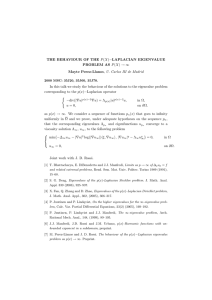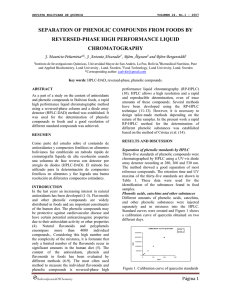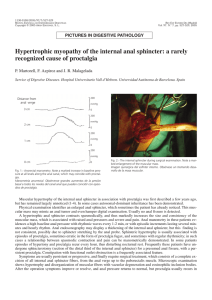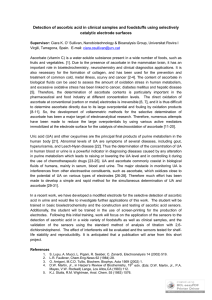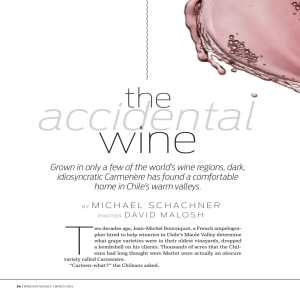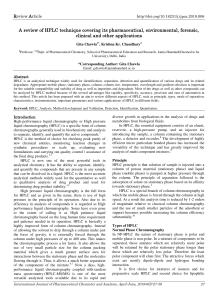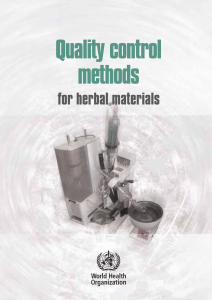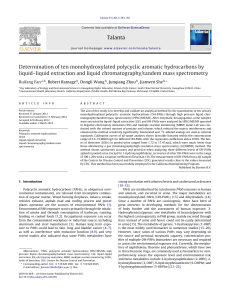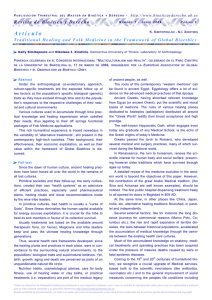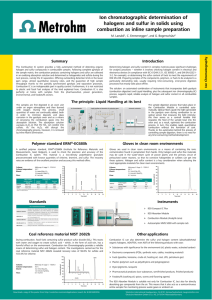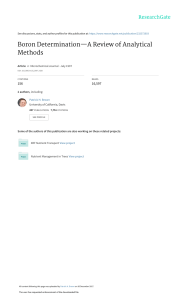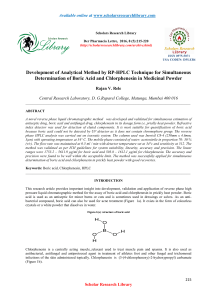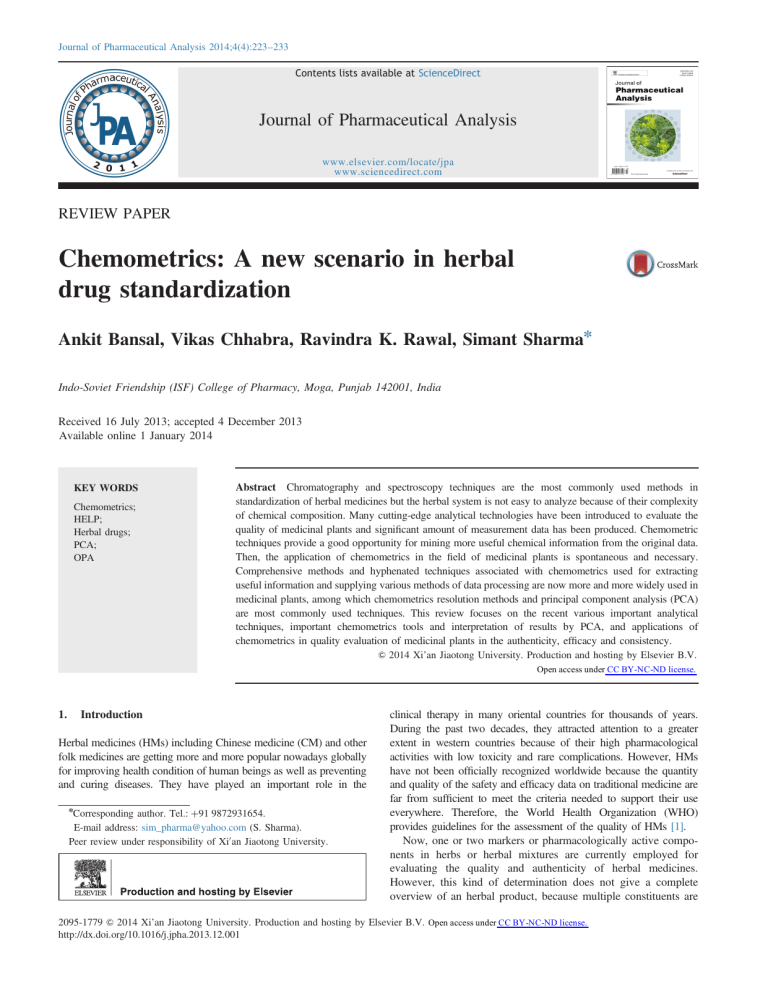
Journal of Pharmaceutical Analysis 2014;4(4):223–233 Contents lists available at ScienceDirect Journal of Pharmaceutical Analysis www.elsevier.com/locate/jpa www.sciencedirect.com REVIEW PAPER Chemometrics: A new scenario in herbal drug standardization Ankit Bansal, Vikas Chhabra, Ravindra K. Rawal, Simant Sharman Indo-Soviet Friendship (ISF) College of Pharmacy, Moga, Punjab 142001, India Received 16 July 2013; accepted 4 December 2013 Available online 1 January 2014 KEY WORDS Chemometrics; HELP; Herbal drugs; PCA; OPA Abstract Chromatography and spectroscopy techniques are the most commonly used methods in standardization of herbal medicines but the herbal system is not easy to analyze because of their complexity of chemical composition. Many cutting-edge analytical technologies have been introduced to evaluate the quality of medicinal plants and significant amount of measurement data has been produced. Chemometric techniques provide a good opportunity for mining more useful chemical information from the original data. Then, the application of chemometrics in the field of medicinal plants is spontaneous and necessary. Comprehensive methods and hyphenated techniques associated with chemometrics used for extracting useful information and supplying various methods of data processing are now more and more widely used in medicinal plants, among which chemometrics resolution methods and principal component analysis (PCA) are most commonly used techniques. This review focuses on the recent various important analytical techniques, important chemometrics tools and interpretation of results by PCA, and applications of chemometrics in quality evaluation of medicinal plants in the authenticity, efficacy and consistency. & 2014 Xi’an Jiaotong University. Production and hosting by Elsevier B.V. Open access under CC BY-NC-ND license. 1. Introduction Herbal medicines (HMs) including Chinese medicine (CM) and other folk medicines are getting more and more popular nowadays globally for improving health condition of human beings as well as preventing and curing diseases. They have played an important role in the n Corresponding author. Tel.: þ91 9872931654. E-mail address: sim_pharma@yahoo.com (S. Sharma). Peer review under responsibility of Xi0 an Jiaotong University. clinical therapy in many oriental countries for thousands of years. During the past two decades, they attracted attention to a greater extent in western countries because of their high pharmacological activities with low toxicity and rare complications. However, HMs have not been officially recognized worldwide because the quantity and quality of the safety and efficacy data on traditional medicine are far from sufficient to meet the criteria needed to support their use everywhere. Therefore, the World Health Organization (WHO) provides guidelines for the assessment of the quality of HMs [1]. Now, one or two markers or pharmacologically active components in herbs or herbal mixtures are currently employed for evaluating the quality and authenticity of herbal medicines. However, this kind of determination does not give a complete overview of an herbal product, because multiple constituents are 2095-1779 & 2014 Xi’an Jiaotong University. Production and hosting by Elsevier B.V. Open access under CC BY-NC-ND license. http://dx.doi.org/10.1016/j.jpha.2013.12.001 224 A. Bansal et al. usually accountable for its therapeutic actions and effectiveness. These multiple constituents may work ‘synergistically’ and could hardly be separated into active parts [2,3]. There are various techniques that are used for this sort of determination like high-performance liquid chromatography (HPLC), gas chromatography (GC), ultra-high performance liquid chromatography (UHPLC) and thin layer chromatography (TLC). Moreover, the recent approaches including hyphenated chromatography and spectroscopy like high-performance liquid chromatography-diode array detection (HPLC-DAD), gas chromatography–mass spectrum analysis (GC– MS), capillary electrophoresis-diode array detection (CE-DAD), HPLC–MS and HPLC–nuclear magnetic resonance (NMR) might give the additional spectral information which may be helpful for the qualitative and quantitative analysis and even for the structural elucidation. With spectral information, the hyphenated instruments show greatly improved performances in terms of the elimination of the instrumental interferences, retention time shift correction, selectivity, chromatographic separation abilities, measurement and precision. Since complicated data from these techniques cannot be evaluated easily, we need data processing techniques for this purpose. These techniques provide a good opportunity for mining more useful chemical information from original information-rich data. Chemometrics is the application of mathematical and statistical techniques to retrieve more information from the chromatographic data [4–6]. The International Chemometrics Society (ICS) defines chemometrics as the science of relating measurements made on a chemical system or process to the state of the system via application of mathematical or statistical methods [7]. It promotes equipment intellectualization and offers new ideas and methods for the construction of new and high-dimensional and hyphenated equipments. Furthermore, with the rapid development of the microcomputer and retrieval of the analysis of highdimensional data, artificial neural networks, research of artificial intelligence of chemistry and expert systems have made great progress. With the development of analytical chemistry, chemometrics is also being developed vigorously [8,9]. With the advance of computer technology, chemometrics methods have become a leading tool among the scientific communities towards faster analysis results and shorter product development time. Among others, an unsupervised pattern recognition technique such as principal component analysis (PCA) is the most often used method for handling multivariate data without prior knowledge about the studied samples. While the supervised classification procedure using soft independent modeling of class analogy (SIMCA) based on making a PCA model to assign unknown samples into the predefine class model has also been applied to the analysis. Thus, the application of chemometrics techniques will greatly improve the quality of the fingerprint obtained (Fig. 1) [4,9,10]. Fig. 1 In this review, we have discussed the origin and development of chemometrics in the first part and further stressed various important chromatographic techniques for HDs fingerprint development. Furthermore, multivariate methods that are used to extract the information from the chromatographic data like pretreatment of chromatogram, multivariate resolution methods and various classification and discrimination methods applied in the chemical analysis of herbal drugs have been discussed. In the final part, we have discussed its application in herbal drug standardization with respect to authenticity and determination of chemical components by analytical techniques, especially on the use of chemometrics in combination with chromatographic fingerprint for quality evaluation based on active ingredients. 2. Origin and development of chemometrics A Swedish scientist Svante Wold in 1971 coined term “kemometri” in Swedish form and its English equivalent is “chemometrics” [11]. In year 1986 and 1987 two journals were started named as “Chemometrics and Intelligent Laboratory Systems” and “Journal of Chemometrics”, which promoted equipment intellectualization and offered new methods for the construction of new and highdimensional hyphenated equipment. These hyphenated equipments have opened many new options for data analytical method improvement. Now, chemometrics has emerged to have a major role within the analytical chemistry [12]. 3. Herbal drugs chromatographic fingerprinting Herbal drugs may contain a large number of compounds even though many of them are present in low concentrations but they may be important in terms of quality, safety and efficacy of the herbal medicines because they show synergetic effects and their therapeutic actions are based on interaction between numerous constituents. In order to evaluate the complete pattern of herbal medicine, chromatography offers a powerful tool for separating the individual components and developing a characteristic profile of the sample, called a fingerprint. This section basically deals with different chromatographic techniques used for herbal fingerprinting and their advantages and disadvantages. 3.1. Thin layer chromatography (TLC) TLC is a technique used for fast screening of samples to identify herbal products and to differentiate between herbal species [13–16]. One of the major advantages of TLC is its tractability to optimize operational parameters, such as the sample application, plate Schematic interpretation of complicated data comes from various hyphenated instruments by various chemometrics techniques. Chemometrics in herbal drug standardization development and derivatization. The main disadvantages of TLC in the analysis and quality control of HDs are its low reproducibility and resolution [16–18], need for high compound concentration for detection [16] and the semi-quantitative nature of the technique. The main factors that are hard to control in TLC and affect its precision include sample spotting, saturation of the developing chamber and the instability of color appearance when coloring reagents are used for detection [16]. Nevertheless, TLC is still being used as it is a promptly available, easy to use and economical technique and recent developments and modifications of the technique remarkably improved its reproducibility, resolution and sensitivity. Digital scanning and documentation software have improved the applicability of TLC for the comprehensive identification and assessment of HDs resulting in a more adequate extraction of the information. In addition, high performance thin layer chromatography (HPTLC) by using a smaller particle size range (5–20 mm) and automation of different steps increase the reproducibility and resolution [13,16,17,19]. Micro-emulsion TLC (ME-TLC) development leads to increased separation efficiency and signal enhancement and resulting in an improved sensitivity [16]. Other accepted modifications in herbal analysis include TLC densitometry [20], two-dimensional TLC (2D-TLC) [21,22] and coupledlayer planar chromatography (graft-TLC) [22]. 3.2. High performance liquid chromatography (HPLC) HPLC is the most popular analytical technique used in HDS [23–25]. HPLC is easy to operate and a fully automatable technique with high rates of precision, resolution, selectivity and sensitivity. One of the main advantages of HPLC is the possibility to make hyphenation with different detectors such as ultra violet (UV) for UV absorbing compounds [25–27], and diode array detector (DAD) for herbal fingerprinting [24,28,29], evaporative light scattering detector (ELSD) [27] and chemo luminescence detectors (CL) for non-UV absorbing compounds, NMR for metabolomic profiling [30] and mass spectrometry (MS) for identification of the separated compounds [28,31,32]. However, the main drawback in HPLC is the requirement of expensive machinery, large volumes of environmentally unfriendly liquids, the undetected co-elution of compounds and the susceptibility of conventional (silica-based) columns to relatively basic (pH49) or acidic (pHo2) mobile phases and high temperatures. An important factor in fingerprint development is the selection of stationary phase. Commonly used stationary phases for herbal fingerprinting are particlebased C-8, C-12 and C18 columns, and efficiency of these columns is dependent on their particle size (currently 3–5 mm). Smaller particle size drastically increases the backpressure: when the particle size is halved, the pressure quadruples. As the current HPLC instrumentation can withstand up to 6000 psi, higher efficiencies and shorter separation times by decreasing particle size and increasing the flow rates are limited [33,34]. 3.3. Ultra-high performance liquid chromatography (UHPLC) In recent years, UHPLC has been emerging as a feasible technique for the quality control of herbal products. UHPLC can withstand a pressure of at most 8000 psi and it brings liquid chromatographic analysis to another level by hardware modifications of the conventional HPLC machinery [35]. UHPLC makes it possible to perform high resolution separations superior to HPLC analysis 225 by using solid phase particles of less than 2 mm in diameter to achieve superior sensitivity and resolution. Smaller particle size leads to higher separation efficiency and shorter columns size leads to shorter analysis time with little solvent consumption [35]. Within a period of last few years, UHPLC fingerprints of herbal products were developed instead of conventional HPLC approach [36,37]. In comparison to HPLC, UHPLC analyses reported a decreased analysis time by a factor up to eight without loss of information [38,39]. The results obtained not only showed decreased analysis time but also proved a great enhancement in selectivity compared to conventional HPLC analysis. 3.4. Hydrophilic interaction chromatography (HILIC) HILIC has gained attention in herbal fingerprinting because of good separation quality of hydrophilic compounds. Many of polar compounds of herbal medicines are extracted by using aqueous solution which might be better separated by means of HILIC [40]. HILIC was introduced as an alternative for normal-phase liquid chromatography (NPLC); HILIC enables the separation of polar compounds on polar stationary phases with aqueous mobile phases. It is based on the principle of partitioning between a water-enriched layer in the hydrophilic stationary phase and a relatively hydrophobic mobile phase usually containing 5–40% water in organic solvent. This technique is more eco-friendly as compared to NPLC because of the use of water and polar organic solvents as mobile phase. In addition, the polar compounds are more soluble in the mobile phase of HILIC [40,41]. As HILIC is a relatively recent technique, few papers analyzing herbal products have been published yet. Most papers usually describe a methodology exploiting the orthogonal character of the HILIC and reversed-phase liquid chromatography (RPLC) methods for quality control [41,42]. 3.5. Gas chromatography (GC) GC is a well established analytical technique commonly used for the characterization, quantization and identification of volatile compounds. The powerful separation efficiency and sensitive detection make GC a useful tool for the analysis of essential oils [43]. Despite its advantages, GC analysis of herbal products is usually limited to the essentials oils because of possible degradation of thermo-labile compounds and the requirement of volatile compounds makes GC unsuitable for many herbal compounds [44]. The hyphenation of GC–MS leads to reducing analysis times of essential oils (40–100 s) as well as decreased detection limits. GC–MS analysis of essentials oils, showing faster analysis and high efficiency, made use of micro-bore capillary columns [45] with reduced stationary phase film thickness (10 m 100 mm I.D. and 5 m 50 mm I.D.) with rapid temperature programming (20 1C/s), fast data acquisition by FID and high split ratio. Finally, low-pressure GC–MS using mega-bore analytical columns (10 m 530 mm with 0.25–1 mm film thickness) was investigated on the essential oils and led to a slightly reduced efficiency but manifold decreased analysis times [46,47]. 3.6. Two-dimensional (2D) chromatography Before going to 2D chromatography, firstly one has to understand the difference between multi-dimensional fingerprint generated by hyphenated detection techniques and 2D chromatography. In multi-dimensional fingerprinting, the hyphenated detector 226 A. Bansal et al. collects information from the eluting compounds while a fingerprint is recorded. In 2D chromatography, fractions eluting from a first chromatographic system are chromatographed on a second system having different separation properties resulting in increased the peak capacity of entire separation (Fig. 2). To reveal all characteristics of complex HDs, 2D chromatography was proposed. With the development of 2D chromatographic systems, a new era in herbal fingerprinting has been clicked. The main advantage of 2D chromatography over conventional onedimensional chromatography is to obtain high peak capacity which theoretically equals to the product of the peak capacities of two individual dimensions. However, a major limitation is very long time span needed to reach this maximum capacity [48]. Literature review reveals that 2D chromatography has been used with different techniques such as 2D TLC [21], 2D HPLC [49], 2D GC [50] and 2D chromatography combining size-exclusion and RPLC [51]. 4. Common chemometric tools used in chemical analysis of herbal drugs As is known, HPLC is extensively applied for quality control of herbal drugs due to its sensitivity, superior precision, high Fig. 2 resolution and extensive applicability. LC–MS, GC–MS, and LC– NMR have been increasingly used in complex chemical identification of HDs [52]. This advancement in instrumentation is able to generate enormous amounts of data which record small differences between samples and this enables us to provide large implications for the discrimination of herbal plants. So we discuss here application of chemometrics in the analysis of herbal drugs. But before analyzing data, pretreatment of data is essential because unknown components or unclear interferences cause overlapped peaks and shifted baseline. Thus, we discuss here various commonly used chemometric techniques in herbal drug standardization (HDS) such as PCA, linear discriminate analysis (LDA), spectral correlative chromatography (SCC), information theory (IT), local least square (LLS), heuristic evolving latent projections (HELP) and orthogonal projection analysis (OPA). 4.1. Tools for preprocessing data To eliminate or reduce unwanted sources of variations due to instrumental responses from hyphenated techniques and to obtain more efficient results, data preprocessing techniques are applied. Commonly applied preprocessing techniques include LLS and normalization. To obtain accurate quantitative results from the fingerprint, pretreatment of chromatographic data is necessary. 3D data obtained from 2D LC/MS (HPLC–HPLC–TOF/MS) and resolution of data by employing PCA and HELP. Chemometrics in herbal drug standardization 227 4.1.1. Normalization Variation in sample concentration might affect the multivariate analysis of the entire chromatographic profile. So normalization of data is examined before carrying out multivariate analysis in the following way: each chromatogram consists of N peaks with each peak area ci of the ith component being utilized. The total area of all peaks can be calculated by N C ¼ ∑ ci i¼1 So the peak area after normalization is as follows: ci ci ¼ C ð1Þ ð2Þ Then, each peak is expressed as percentage of the sum of peak areas [53]. 4.1.2. Local least square (LLS) method Major problem in analyzing HDs is occurrence of signal shift. It causes a significant influence in chromatographic profile. To eliminate the chromatographic shift, the LLS method is used to correct retention time shift. When we are using pattern approach, then it is necessary to correct retention time in all chromatograms unless it causes serious problem. To match all chromatographic profiles with their retention times, all common constituents will be selected and utilized for chromatographic alignment [54]. 4.2. Tools for extracting chemical information The aim of these methods is to detect similarities or extract useful information from the data obtained from analytical instrument. These methods are important for finding out the interested analyte in complex mixture of plant fingerprint and similarity analysis (SA), SCC and IT are commonly used tools. 4.2.1. SCC It is a technique used to identify the chemical component present in different chromatograms as acquired from hyphenated instrument. It is based on the fact that the same chemical components should have the same spectra no matter what or how they are eluted through diverse chromatographic columns. The spectral information is utilized to pick up the targeted component from the other two-way chromatograms. The procedure for carrying out SCC is given in the following steps: 1. Assess peak purity of targeted component and obtain its UV or MS spectrum from the chromatogram. 2. Identify this component in the chromatogram of interest through comparison by a series of spectrum at each scan point of other chromatogram by their correlation coefficients. 3. Get a curve of the correlation coefficient versus scan point in the direction of retention time and further validate step 2 with consideration of the information in the local chromatographic cluster where the target exists. The result obtained by SCC is highly accurate in the case of MS because the mass spectrum provides uniqueness compared to the UV spectrum [55]. 4.2.2. Information theory (IT) The value of information content depends on the separation degree and concentration distribution of each chemical component in a chromatogram. The more they separate with uniform concentrations, the higher the value of information contents, i.e., more chemical information can be obtained from this chromatogram. Information content Φ of a chromatogram is calculated using following equation: Z px log ðpx Þ Φ¼ ð3Þ dx sumðpx Þ sumðpx Þ where px is the real chromatographic response of all chemical components involved in the chromatogram. By comparing the magnitude of information content, maximal chemical information under certain chromatographic conditions that include all extraction and detection parameters can be found out [56]. 4.3. Tools for resolution of mixtures The main goal in the analysis of any multicomponent system is to get useful information from the raw experimental data and knowledge of the number of chemical components in the analyzed sample, especially in herbal drugs (Fig. 2). The common purpose of all resolution methods is to provide the linear model of individual component contributions using solely the raw experimental measurements. HELP and OPA are two important and commonly used multivariate tools. 4.3.1. HELP HELP is a multivariate resolution method used to resolve two-way bilinear data into spectra and chromatograms of the pure constituents [57,58]. This method employs the feature of visual interface from latent variable projection graph and also provides information of the local rank of the data matrix. This method employs the following steps: 1. To find out the total number of components by employing singular value decomposition (SVD). 2. Further, eigenvalue plot is constructed which is plotted between logarithms of eigenvalues against retention time. 3. Then in the next step zero concentration regions and selective concentration region of the compound are determined from eigenvalue plot. Selective concentration region is defined as the region in which only a single component elutes out i.e., having rank equal to one and zero concentration region in which no component elutes out. 4. Then evolving latent projection (ELP) graph gives us information about the selective region of the individual component in wavelength as well as retention time space. Such region can be identified by passing straight lines in ELP graphs. 5. In the end, spectra and chromatogram of individual components can be resolved through simple mathematic computation S ¼ ðC T CÞ 1 CT X ð4Þ where X represents data matrix generated by hyphenated system with total rows representing spectral profile S and columns showing chromatograms C. 4.3.2. OPA OPA is a stepwise process and selects one key variable in each step [59,60]. This method calculates dissimilarity based on the mathematical concept of orthogonalisation [61,62]. The method is based on the fact that pure spectra are extreme spectra and will 228 A. Bansal et al. encompass the mixture spectra. OPA compares each spectrum with one or more than one reference spectra and searches for the least correlated spectrum. The first dissimilar plot represents a comparison of each spectrum with the average spectrum. The procedure of OPA consists of three steps 1. Comparison of each spectrum of data matrix X with spectra used in equation d i ¼ detðY Ti Y i Þ i ¼ 1; 2………m ð5Þ where dissimilarity of the ith spectrum, di, is defined as the determinant of the dispersion matrix of Yi. In general, matrices Yi consist of one or more reference spectra and the spectrum measured at the ith analysis time. 2. Plotting of the dissimilarity plot between dissimilarity values and analysis time. 3. Then in the last step selection of the spectrum with the highest dissimilarity value by including it as reference in matrix Yi. 4.4. Tools for displaying data These tools are useful to resolve net analytical signal by discovering the dominant factors while excluding the relevant interference, thus giving a more accurate estimate. These include various methods such as LDA, hierarchical clustering analysis (HCA), SIMCA and PCA, but among these PCA and LDA are found to be most commonly used. 4.4.1. PCA The central idea of PCA is to reduce the dimensionality of a data set consisting of a large number of interrelated variables, while keeping maximum variation in the data set. This is accomplished by transforming to latent variables (Fig. 3), the principal components (PCs) that are uncorrelated and ordered so that the first few PCs retain most of the variation in all of the original variables [63,64]. PCA [63,65], a multivariate tool, is used to find out the main source of variability present in the data sets. It is used to detect cluster formatting and to establish relationship between object and variable. The sample variation in data is given in terms of latent variable as given below: A X ¼ UPt ¼ ∑ ui pti i¼1 ð6Þ where X is a given data matrix, ui and pi are score and loading vector, respectively and orthogonal to each other. Generally score matrix (U) gives the relationship between samples while loading matrix (P) shows the importance of each variable (Fig. 3). When a fingerprint with unexpected features that differ from those of majority fingerprint is encountered, it will be analyzed differently and displayed as outlier. Their difference in score plot can be expressed by a measure of distance like euclidean distance (EDA). qffiffiffiffiffiffiffiffiffiffiffiffiffiffiffiffiffiffiffiffiffiffiffiffiffiffiffiffiffiffiffiffiffiffiffiffiffiffiffiffiffiffi ð7Þ EDA ¼ ðxtest xA Þðxtest xA ÞT EDB ¼ qffiffiffiffiffiffiffiffiffiffiffiffiffiffiffiffiffiffiffiffiffiffiffiffiffiffiffiffiffiffiffiffiffiffiffiffiffiffiffiffiffiffi ðxtest xB Þðxtest xB ÞT ð8Þ xA and xB are the mean of training set for herb A and herb B, respectively [64,66]. 4.4.2. LDA LDA is a supervised pattern recognition method. It seeks a linear function of the variable in multivariate space which maximizes the ratio between both variances compared to the within-group variance. Since multi-dimensional data arise when the number of variables larger than the number of observations, then we cannot use LDA directly. In that case PCA is employed to compress data and to transform the original dataset comprising of a large number of inter-correlated variables into a reduced new set of variables. LDA makes a discriminate function for each group according to this equation: n FðGi Þ ¼ k i þ ∑ wij pij j¼1 ð9Þ where i is number of groups (G), ki is the constant of each group, n is number of parameters used to classify a set of data into a given group and wj is weight coefficient, assigned by LDA to a selected parameter (pi) [67,68]. 5. Application of chemometrics in HDS We will describe the application of chemometrics in HDS by giving detailed examples regarding authenticity, efficacy and chemical analysis of HDs. Fig. 3 Interpretation of 3 dimensional data by using first 2 principal components where score vector ui gives grouping in data sets and loading vector pi direction of variability in data sets. Chemometrics in herbal drug standardization 5.1. Authenticity Ascertaining authenticity is the important step to assess the quality of plant medicine. Each medicinal plant contains certain characteristic constituents. Therefore, constituents including their respective chemical ratios can be analyzed to identify medicinal plants and distinguish the fakes. The analysis of fingerprint of 46 Cassia seeds samples was carried out by applying chemometric methods at two wavelengths of HPLC–UV. Samples were clustered into four groups according to the plant sources and preparation procedures. Chemometric tools were effectively applied to predict the category of the four different samples in the test set [69]. Several studies concerning the quality control of Camellia sinensis have been undertaken. The total antioxidant capacity of C. sinensis extracts is considered as an important quality criterion. Different regression models such as PCA and OPA were applied for the prediction of total antioxidant capacity using chromatographic fingerprints [70–72]. Ultra-high performance liquid chromatography–electrospray ionization-mass spectrometry (UHPLC–ESI-MS) was utilized for metabolite profiling of saponins to discriminate Panax notoginseng parts in order to classify them according to their phytochemical diversity and saponins accounting for such variations were identified through the loading plots of PCA [73,74]. The high performance liquid chromatography-diode array detector (HPLC-DAD) method was used to determine 10 triterpenoid acids simultaneously. The present HPLC-DAD method, combined with chemometrics, was demonstrated to be very helpful in searching Ziziphus jujuba resources and possibly useful in chemotaxonomic characterization [75]. Data of HPLC analyses of Ocimum americanum, O. basilicum, O. Citriodorum and O. Minimum were utilized for authentication purposes to determine the surface flavonoid of different basil cultivar by applying PCA [76,77]. Atractylis chinensis is a medicinal plant used for establishment of HPLC fingerprints together with the metal profile which was used to assess the quality procedures and data were evaluated by using PCA and LDA. The results obtained showed that the samples were discriminated on the basis of the processing methods [78]. HPLC-DAD method was developed to evaluate the quality of Receptaculum Nelumbinis (dried receptacle of Nelumbo nucifera) through establishing chromatographic fingerprint and simultaneous determination of five flavonol glycosides, including hyperoside, isoquercitrin, quercetin-3-O-β-D-glucuronide, isorhamnetin-3-O-βD-galactoside and syringetin-3-O-β-D-glucoside [79]. To evaluate the quality consistency of commercial medicinal herbs, a simple and reliable HPLC method with a UV/vis detector was developed, both for fingerprint analysis and quantitation of some pharmacologically active constituents. Melissa officinalis L. (lemon balm) was chosen for this study because it is widely used as an aromatic, culinary and medicine remedy [80]. Fourier transform infrared (FTIR) and chemometrics have been used to analyze adulteration in cod liver oil (CLO). This method successfully allowed one to make a classification of pure CLO and adulterated CLOs with vegetable oils [81]. HPLC fingerprint analysis followed by PCA and discriminate analysis (DA) provided good discrimination of Cinnamomum cassia bark and twings samples and cinnamaldehyde was found to be the most abundant marker component [82]. A simultaneous fingerprinting analysis of some kiwi and pomelo fruits has been performed by employing HPLC and UV/vis spectroscopy, followed by application of chemometric tools such as cluster analysis, PCA and LDA for data analysis. The digitized chromatograms provided a better 229 classification and discrimination of these fruit samples than the UV/vis spectra [83]. Herbs (mint, thyme and rosemary) and spices (black pepper, chili pepper, cinnamon, cumin, sweet red pepper and turmeric) were analyzed using atomic spectrometry. Principle component analysis and HCA classified the samples into five groups and LDA was used to show how these group members were correctly classified with regard to the original group [84]. Ultra-performance liquid chromatography-quadrupole time-offlight mass spectrometry (UPLC–QTOF/MS) and multivariate statistical analysis were used to investigate the processing technology of Loquat (Eriobotrya japonica) leaf (pipaye, PPY). The differences in samples processed under different methods were revealed by unsupervised PCA [85]. HPLC-DAD–MS method has been developed and compared with the fingerprints of another non-official species Cistanche salsa and Cistanche sinensis with the official one Cistanche deserticola. It is found that C. salsa has high similarity with the standard while C. sinensis is suggested that C. salsa may be used as an alternative species [86]. Notopter giumincium having complex fingerprint obtained by GC–MS is resolved by using OPA [87]. A similar study was carried out for Artemisia capillaries with the aid of a fixed size moving window evolving factor analysis (FSMWEFA) [88]. Several studies were conducted for quality control of the herb Houttuynia cordat utilizing FSMWEFA, PCA and subwindow factor analysis (SFA) [89–91]. 5.2. Efficacy and consistency The efficacy of plant medicines is closely related to their chemical constituents and their concentrations. Consistency may slightly vary according to differences in climate, cultivating and harvest time, possessing procedure and storage. Evaluating the recorded fingerprints, minor differences in concentrations might influence the quality of the herbal plant while small differences between the fingerprints can discriminate among species. PCA, SSC and LDA can classify and discriminate medicinal plants fingerprints effectively. Fingerprint analysis of Chrysanthemum morifolium was developed by combining chemometric methods such as SA, HCA, and PCA with ultra-performance liquid chromatography [92]. Ultra-performance liquid chromatography with photodiode array detector (UPLC-PAD) method for quantitative analysis of five active alkaloids of Rhizoma coptidis has been developed. For the classification of samples, chromatographic data were analyzed by SA, PCA and HCA. This method, in combination with chemometrics, demonstrated to be very helpful in the quality control and evaluation of R. coptidis [12]. PCA, SIMCA and HCA were applied to HPLC fingerprint of Epimedium wushanenseas in order to identify and distinguish their secondary metabolites [93,94]. Differentiation of Teucrium flavum was carried out by GC–MS and then investigation of their chemical and genetic profiles was carried out by utilizing application of PCA and cluster analysis (CA) as classification methods. The obtained results showed that the genetic background was solely responsible for differences in the volatile oil composition [95]. In another study, differentiation and prediction of cultivation age using ginseng samples cultivated under standardised protocols or guidelines were investigated by NMR-based metabolomics techniques using various solvents to develop a differentiation method for ginseng cultivation age. The PLS-DA method has successfully differentiated the 1–6 years old ginseng root samples [96]. A method 230 A. Bansal et al. for chemical fingerprint analysis of Hibiscus mutabilis leaves was developed by using UPLC-PAD combined with SA and HCA [97]. Fourier transform-mid-infra-red (FT-MIR) spectra were investigated for discrimination between Coffea arabica and C. canephora and PCA revealed clear grouping of the spectra according to species followed by DA based on the PCA scores which yielded 100% successful discrimination [98]. A combination of FT-IR with CDA has been applied to distinguish 70 Greek Mentha pulegium samples according to their geographical locations where the main spectral features for the discrimination of samples among the different collection areas occur primarily in the carbonyl region and are correlated with the main volatile constituents of the extracts [99]. The combined data matrices of both HPLC-DAD and GC–MS were utilized for the analysis of complex traditional Chinese medicinal (TCM) plant R. Curcumae and evaluation of data by the use of PCA showed a reasonable separation of the samples for each technique [100]. Enhanced fingerprints of various Artemisia selengensis by means of HPLC-DAD were developed, and obtained results were analyzed by SA, HCA and PCA and proved to be satisfactory for matching and discrimination of A. Selengensis [101]. Thus, the enhanced fingerprinting analysis combined with chemometric methods is a novel, valid and rapid technique which would provide a powerful and meaningful tool to comprehensively conduct quality control of HDs. 6. Future prospects The power of chemometrics in the field of HDS needs no more description. Chemometrics is used in optimizing experimental procedures, extracting useful information from the chromatographic data and resolution of the mixture into linear components. Chemometrics is found to be a useful tool in estimating the quality of HDs [102,103] but we should also remember that standardization of HDs chromatographic fingerprint is not always a perfect way to present all compounds, even though there are a number of monographs on quality evaluation of plants in some countries, but still we lack an effective standard to make scientific quality estimation [104]. To assess the quality of medicinal plants, new ways are regularly being explored such as combination chemical fingerprint with biological methods, bio-fingerprint and metabolic fingerprint [26,40,104–106]. Quality metrology, pharmacodynamics and export system of medicinal plants have been researched in some groups [107] but we still require a significant amount of work to achieve a perfect system for quality evaluation of herbal drugs. Acknowledgments Ankit Bansal is grateful to AICTE, New Delhi and PSCST, Punjab (Project PSO/POS/80/9334) for financial support. Authors are also thankful to Mr. Parveen Garg chairman of ISFCP, Moga for supporting this work. References [1] WHO, General Guidelines for Methodologies on Research and Evaluation of Traditional Medicines, 2000, p. 1. [2] A. De Juan, R. Tauler, Chemometrics applied to unravel multicomponent processes and mixtures: revisiting latest trends in multivariate resolution, Anal. Chim. Acta 500 (2003) 195–210. [3] Y.Z. Liang, P. Xie, K.C. Chan, Quality control of herbal medicines, J. Chromatogr. B 812 (2004) 53–70. [4] K. Wiberg. Multivariate Spectroscopic Methods for the Analysis of Solutions, Akademitryck AB, Edsbruk, Stockholm, 2004. [5] B. Lavine, J. Workman, Chemometrics, Anal. Chem. 82 (2010) 4699–4711. [6] L.S. Ramos, K.R. Beebe, W.P. Carey, et al., Chemometrics, Anal. Chem. 58 (1986) 294–315. [7] P. Gemperline, Practical Guide to Chemometrics, CRC, Boca Raton, Florida, 2006. [8] G.M. Escandar, P.C. Damiani, H.C. Goicoechea, et al., A review of multivariate calibration methods applied to biomedical analysis, Microchem. J. 82 (2006) 29–42. [9] D. Jing, H. Linfang, Application of chemometrics in quality evaluation of medicinal plants, J. Med. Plants Res. 5 (2006) 4001–4008. [10] M. Ortiz, L. Sarabia, Quantitative determination in chromatographic analysis based on n-way calibration strategies, J. Chromatogr. A 1158 (2007) 94–110. [11] R. Kiralj, M. Ferreira, The past, present, and future of chemometrics worldwide: some etymological, linguistic, and bibliometric investigations, J. Chemometr. 20 (2006) 247–272. [12] W.J. Kong, Y.L. Zhao, X.H. Xiao, et al., Quantitative and chemical fingerprint analysis for quality control of Rhizoma Coptidischinensis based on UPLC-PAD combined with chemometrics methods, Phytomedicine 16 (2009) 950–959. [13] A.D. Kaur, V. Ravichandran, P.K. Jain, et al., High-performance thin layer chromatography method for estimation of conessine in herbal extract and pharmaceutical dosage formulations, J. Pharm. Biomed. Anal. 46 (2008) 391–394. [14] S. Apers, T. Naessens, L. Pieters, et al., Densitometric thin-layer chromatographic determination of aescin in a herbal medicinal product containing Aesculus and Vitis dry extracts, J. Chromatogr. A 1112 (2006) 165–170. [15] E. Marchand, M.A. Atemnkeng, S. Vanermen, et al., Development and validation of a simple thin layer chromatographic method for the analysis of artemisinin in Artemisia annua L. plant extracts, Biomed. Chromatogr. 22 (2007) 454–459. [16] S. Cui, B. Fu, F.S.C. Lee, et al., Application of microemulsion thin layer chromatography for the fingerprinting of licorice ( Glycyrrhiza spp.), J. Chromatogr. A 828 (2005) 33–40. [17] G. Biringanine, M.T. Chiarelli, M. Faes, et al., A validation protocol for the HPTLC standardization of herbal products: application to the determination of acteoside in leaves of Plantago palmata Hook. f.s, Talanta 69 (2006) 418–424. [18] R.J. Vanhaelen-Fastre, M.L. Faes, M.H. Vanhaelen, High-performance thin-layer chromatographic determination of six major ginsenosides in Panax ginseng, J. Chromatogr. A 868 (2000) 269–276. [19] S. Chopra, F.J. Ahmad, R.K. Khar, et al., Validated high-performance thin-layer chromatography method for determination of trigonelline in herbal extract and pharmaceutical dosage form, Anal. Chim. Acta 577 (2006) 46–51. [20] E. Blanco, M.C. Casais, M.C. Mejuto, et al., Combination of offline solid-phase extraction and on-column sample stacking for sensitive determination of parabens and p-hydroxybenzoic acid in waters by non-aqueous capillary electrophoresis, Anal. Chim. Acta 647 (2009) 104–111. [21] Ł. Cieśla, A. Bogucka-Kocka, M. Hajnos, et al., Two-dimensional thin-layer chromatography with adsorbent gradient as a method of chromatographic fingerprinting of furanocoumarins for distinguishing selected varieties and forms of Heracleum spp., J. Chromatogr. A 1207 (2008) 160–168. [22] Ł. Cieśla, M. Hajnos, M. Waksmundzka-Hajnos, Application of hydrophilic interaction TLC systems for separation of highly polar glycosidic compounds from the flowers of selected Verbascum species, Planar Chromatogr. -Mod. TLC 24 (2011) 295–300. [23] J. Faghihi, X. Jiang, R. Vierling, et al., Reproducibility of the highperformance liquid chromatographic fingerprints obtained from two soybean cultivars and a selected progeny, J. Chromatogr. A 915 (2001) 61–74. Chemometrics in herbal drug standardization [24] G.H. Lu, K. Chan, Y.Z. Liang, et al., Development of highperformance liquid chromatographic fingerprints for distinguishing Chinese Angelica from related umbelliferae herbs, J. Chromatogr. A 1073 (2005) 383–392. [25] Y. Li, T. Wu, J. Zhu, et al., Combinative method using HPLC fingerprint and quantitative analyses for quality consistency evaluation of an herbal medicinal preparation produced by different manufacturers, J. Pharm. Biomed. Anal. 52 (2010) 597–602. [26] X.H. Fan, Y.Y. Cheng, Z.L. Ye, et al., Multiple chromatographic fingerprinting and its application to the quality control of herbal medicines, Anal. Chim. Acta 555 (2006) 217–224. [27] A. Van Nederkassel, V. Vijverman, D. Massart, et al., Development of a Ginkgo biloba fingerprint chromatogram with UV and evaporative light scattering detection and optimization of the evaporative light scattering detector operating conditions, J. Chromatogr. A 1085 (2005) 230–239. [28] W. Li, Y. Deng, R. Dai, et al., Chromatographic fingerprint analysis of Cephalotaxus sinensis from various sources by high-performance liquid chromatography-diodearray detection–electrospray ionizationtandem mass spectrometry, J. Pharm. Biomed. Anal. 45 (2007) 38–46. [29] X. Tan, Q. Li, X. Chen, et al., Simultaneous determination of 13 bioactive compounds in Herba Artemisiae Scopariae (Yin Chen) from different harvest seasons by HPLC-DAD, J. Pharm. Biomed. Anal. 47 (2008) 847–853. [30] Y.B. Ji, Q.S. Xu, Y.Z. Hu, et al., Development, optimization and validation of a fingerprint of Ginkgo biloba extracts by highperformance liquid chromatography, J. Chromatogr. A 1066 (2005) 97–104. [31] V. Kumar, N. Mehrotra, J. Lal, et al., Pattern profiling of the herbal preparation picroliv using liquid chromatography–tandem mass spectrometry, J. Chromatogr. A 1045 (2004) 145–152. [32] J. Su, P. Fu, Y. Shen, et al., Simultaneous analysis of flavonoids from Hypericum japonicum Thunb. ex Murray (Hypericaceae) by HPLC-DAD–ESI/MS, J. Pharm. Biomed. Anal. 46 (2008) 342–348. [33] N. Tanaka, H. Kobayashi, Monolithic columns for liquid chromatography, Anal. Bioanal. Chem. 376 (2003) 298–301. [34] G. Guiochon, Monolithic columns in high-performance liquid chromatography, J. Chromatogr. A 1168 (2007) 101–168. [35] L. Nováková, L. Matysová, P. Solich, Advantages of application of UPLC in pharmaceutical analysis, Talanta 68 (2006) 908–918. [36] W. Kong, C. Jin, W. Liu, et al., Development and validation of a UPLC–ELSD method for fast simultaneous determination of five bile acid derivatives in Calculus Bovis and its medicinal preparations, Food Chem. 120 (2010) 1193–1200. [37] C.H. Kuo, C.W. Lee, S.C. Lin, et al., Rapid determination of aristolochic acids I and II in herbal products and biological samples by ultra-high-pressure liquid chromatography–tandem mass spectrometry, Talanta 80 (2010) 1672–1680. [38] B. Avula, Y.H. Wang, R.S. Pawar, et al., A rapid method for chemical fingerprint analysis of Hoodia species, related genera, and dietary supplements using UPLC–UV–MS, J. Pharm. Biomed. Anal. 48 (2008) 722–731. [39] Y. Zhang, H. Xu, X. Chen, et al., Simultaneous quantification of 17 constituents from Yuanhu Zhitong tablet using rapid resolution liquid chromatography coupled with a triple quadrupole electrospray tandem mass spectrometry, J. Pharm. Biomed. Anal. 56 (2011) 497–504. [40] Y. Jiang, B. David, P. Tu, et al., Recent analytical approaches in quality control of traditional Chinese medicines—a review, Anal. Chim. Acta 657 (2010) 9–18. [41] Y. Jin, T. Liang, Q. Fu, et al., Fingerprint analysis of Ligusticum chuanxiong using hydrophilic interaction chromatography and reversed-phase liquid chromatography, J. Chromatogr. A 1216 (2009) 2136–2141. [42] Y. Chen, W. Bicker, J.Y. Wu, et al., Ganoderma species discrimination by dual-mode chromatographic fingerprinting: A study on stationary phase effects in hydrophilic interaction chromatography 231 [43] [44] [45] [46] [47] [48] [49] [50] [51] [52] [53] [54] [55] [56] [57] [58] [59] [60] [61] and reduction of sample misclassification rate by additional use of reversed-phase chromatography, J. Chromatogr. A 1217 (2010) 1255–1265. I. Bombarda, N. Dupuy, J.P. Da, et al., Comparative chemometric analyses of geographic origins and compositions of lavandin var. Grosso essential oils by mid infrared spectroscopy and gas chromatography, Anal. Chim. Acta 613 (2008) 31–39. H. Zhu, Y. Wang, H. Liang, et al., Identification of Portulaca oleracea L. from different sources using GC–MS and FT-IR spectroscopy, Talanta 81 (2010) 129–135. F. David, D. Gere, F. Scanlan, et al., Instrumentation and applications of fast high-resolution capillary gas chromatography, J. Chromatogr. A 842 (1999) 309–319. A.F.L. Godoi, W. Vilegas, R.H.M. Godoi, et al., Application of low-pressure gas chromatography–ion-trap mass spectrometry to the analysis of the essential oil of Turnera diffusa(Ward.) Urb., J. Chromatogr. A 1027 (2004) 127–130. K. Ravindra, A.C. Dirtu, A. Covaci, Low-pressure gas chromatography: recent trends and developments, Trends Anal. Chem. 27 (2008) 291–303. X. Li, D.R. Stoll, P.W. Carr, Equation for peak capacity estimation in two-dimensional liquid chromatography, Anal. Chem. 81 (2008) 845–850. X. Chen, L. Kong, X. Su, et al., Separation and identification of compounds in Rhizoma chuanxiong by comprehensive twodimensional liquid chromatography coupled to mass spectrometry, J. Chromatogr. A 1040 (2004) 169–178. Y. Qiu, X. Lu, T. Pang, et al., Study of traditional Chinese medicine volatile oils from different geographical origins by comprehensive two-dimensional gas chromatography–time-of-flight mass spectrometry (GC GC–TOFMS) in combination with multivariate analysis, J. Pharm. Biomed. Anal. 43 (2007) 1721–1727. I.A. Sutherland, D. Fisher, Role of counter-current chromatography in the modernisation of Chinese herbal medicines, J. Chromatogr. A 1216 (2009) 740–753. M. Ganzera, J. Zhao, I. Khan, Hypericum perforatum—chemical profiling and quantitative results of St. John0 s Wort products by an improved high-performance liquid chromatography method, J. Pharm. Sci. 91 (2002) 623–630. W. Dunn III, D. Stalling, T. Schwartz, et al., Pattern recognition for classification and determination of polychlorinated biphenyls in environmental samples, Anal. Chem. 56 (1984) 1308–1313. B.Y. Li, Y. Hu, Y.Z. Liang, et al., Quality evaluation of fingerprints of herbal medicine with chromatographic data, Anal. Chim. Acta 514 (2004) 69–77. B.Y. Li, Y. Hu, Y.Z. Liang, et al., Spectral correlative chromatography and its application to analysis of chromatographic fingerprints of herbal medicines, J. Sep. Sci. 27 (2004) 581–588. F. Gong, Y.Z. Liang, P.S. Xie, et al., Information theory applied to chromatographic fingerprint of herbal medicine for quality control, J. Chromatogr. A 1002 (2003) 25–40. O.M. Kvalheim, Y.Z. Liang, Heuristic evolving latent projections: resolving two-way multicomponent data. 1. Selectivity, latentprojective graph, datascope, local rank, and unique resolution, Anal. Chem. 64 (1992) 936–946. Y.Z. Liang, O.M. Kvalheim, H.R. Keller, et al., Heuristic evolving latent projections: resolving two-way multicomponent data. 2. Detection and resolution of minor constituents, Anal. Chem. 64 (1992) 946–953. F.C. Sanchez, J. Toft, B. Van den Bogaert, et al., Orthogonal projection approach applied to peak purity assessment, Anal. Chem. 68 (1996) 79–85. F.C. Sanchez, B. Vandeginste, T. Hancewicz, et al., Resolution of complex liquid chromatography–Fourier transform infrared spectroscopy data, Anal. Chem. 69 (1997) 1477–1484. F.C. Sanchez, M. Khots, D. Massart, Algorithms for the assessment of peak purity in liquid chromatography with photodiode-array detection. Part II, Anal. Chim. Acta 290 (1994) 249–258. 232 [62] F.C. Sanchez, M. Khots, D. Massart, et al., Algorithm for the assessment of peak purity in liquid chromatography with photodiode-array detection, Anal. Chim. Acta 285 (1994) 181–192. [63] S. Wold, K. Esbensen, P. Geladi, Principal component analysis, Chemometr. Intell. Lab. Syst. 2 (1987) 37–52. [64] J. Camacho, J. Picó, A. Ferrer, Data understanding with PCA: structural and variance Information plots, Chemometr. Intell. Lab. Syst. 100 (2010) 48–56. [65] I. Jolliffe, Principal Component Analysis, Wiley Online Library, Chichester, UK, 2005. [66] R. Tauler, E. Casassas, Principal component analysis applied to the study of successive complex formation data in Cu (II)–ethanolamine systems, J. Chemometr. 3 (1989) 151–161. [67] S. Axler, Linear Algebra Done Right, Springer, New York, 1997. [68] D.L. Massart, B.G.M. Vandeginste, L. Buydens, Handbook of Chemometrics and Qualimetrics, vol. 20, Elsevier Science, Amsterdam, 1997. [69] Y.H. Lai, Y.N. Ni, S. Kokot, Authentication of Cassia seeds on the basis of two-wavelength HPLC fingerprinting with the use of chemometrics, Chin. Chem. Lett. 21 (2010) 213–216. [70] A. Van Nederkassel, M. Daszykowski, D. Massart, et al., Prediction of total green tea antioxidant capacity from chromatograms by multivariate modeling, J. Chromatogr. A 1096 (2005) 177–186. [71] M. Daszykowski, Y. Vander Heyden, B. Walczak, Robust partial least squares model for prediction of green tea antioxidant capacity from chromatograms, J. Chromatogr. A 1176 (2007) 12–18. [72] M. Dumarey, A. Van Nederkassel, E. Deconinck, et al., Exploration of linear multivariate calibration techniques to predict the total antioxidant capacity of green tea from chromatographic fingerprints, J. Chromatogr. A 1192 (2008) 81–88. [73] M. Dan, M. Su, X. Gao, et al., Metabolite profiling of Panax notoginseng using UPLC–ESI-MS, Phytochemistry 69 (2008) 2237–2244. [74] M. Dan, G. Xie, X. Gao, et al., A rapid ultra-performance liquid chromatography–electrospray ionisation mass spectrometric method for the analysis of saponins in the adventitious roots of Panax notoginseng, Phytochem. Anal. 20 (2009) 68–76. [75] S. Guo, J. Duan, Y. Tang, et al., High-performance liquid chromatography—two wavelength detection of triterpenoid acids from the fruits of Ziziphus jujuba containing various cultivars in different regions and classification using chemometric analysis, J. Pharm. Biomed. Anal. 49 (2009) 1296–1302. [76] R.J. Grayer, R.F. Vieira, A.M. Price, et al., Characterization of cultivars within species of Ocimum by exudate flavonoid profiles, Biochem. Syst. Ecol. 32 (2004) 901–913. [77] R.F. Vieira, R.J. Grayer, A. Paton, et al., Genetic diversity of Ocimum gratissimum L. based on volatile oil constituents, flavonoids and RAPD markers, Biochem. Syst. Ecol. 29 (2001) 287–304. [78] Y. Ni, Y. Peng, S. Kokot, Fingerprinting of complex mixtures with the use of high performance liquid chromatography, inductively coupled plasma atomic emission spectroscopy and chemometrics, Anal. Chim. Acta 616 (2008) 19–27. [79] Y.-B. Wu, L.-J. Zheng, J. Yi, et al., Quantitative and chemical fingerprint analysis for the quality evaluation of receptaculum nelumbinis by RP-HPLC coupled with hierarchical clustering analysis, Int. J. Mol. Sci. 14 (2013) 1999–2010. [80] A. Arceusz, M. Wesolowski, Quality consistency evaluation of Melissa officinalis L. commercial herbs by HPLC fingerprint and quantitation of selected phenolic acids, J. Pharm. Biomed. Anal. 83 (2013) 215–220. [81] A. Rohman, Y.B. Che Man, Application of Fourier transform infrared (FT-IR) spectroscopy combined with chemometrics for authentication of cod-liver oil, Vib. Spectrosc. 55 (2011) 141–145. [82] Y. Ding, E.Q. Wu, C. Liang, et al., Discrimination of cinnamon bark and cinnamon twig samples sourced from various countries using HPLC-based fingerprint analysis, Food Chem. 127 (2011) 755–760. A. Bansal et al. [83] C. Sârbu, R.D. Naşcu-Briciu, A. Kot-Wasik, et al., Classification and fingerprinting of kiwi and pomelo fruits by multivariate analysis of chromatographic and spectroscopic data, Food Chem. 130 (2012) 99–1002. [84] C. Karadaş, D. Kara, Chemometric approach to evaluate trace metal concentrations in some spices and herbs, Food Chem. 130 (2012) 196–202. [85] L. Wu, X. Jiang, L. Huang, et al., Processing technology investigation of loquateriobotrya japonica leaf by ultra-performance liquid chromatography–quadrupole time-of-flight mass spectrometry combined with chemometrics, PLoS One 8 (2013) e64178. [86] Y. Jiang, S. Li, Y. Wang, et al., Differentiation of Herba Cistanches by fingerprint with high-performance liquid chromatography-diode array detection–mass spectrometry, J. Chromatogr. A 1216 (2009) 2156–2162. [87] F.Q. Guo, Y.Z. Liang, C.J. Xu, et al., Determination of the volatile chemical constituents of Notoptergium incium by gas chromatography–mass spectrometry and iterative or non-iterative chemometrics resolution methods, J. Chromatogr. A 1016 (2003) 99–110. [88] F.Q. Guo, Y.Z. Liang, C.J. Xu, et al., Comparison of the volatile constituents of Artemisia capillaris from different locations by gas chromatography–mass spectrometry and projection method, J. Chromatogr. A 1054 (2004) 73–79. [89] C.J. Xu, Y.Z. Liang, F.T. Chau, Identification of essential components of Houttuynia cordata by gas chromatography/mass spectrometry and the integrated chemometric approach, Talanta 68 (2005) 108–115. [90] C.J. Xu, Y.Z. Liang, F.T. Chau, et al., Pretreatments of chromatographic fingerprints for quality control of herbal medicines, J. Chromatogr. A 1134 (2006) 253. [91] Y.X. Zeng, C.X. Zhao, Y.Z. Liang, et al., Comparative analysis of volatile components from Clematis species growing in China, Anal. Chim. Acta 595 (2007) 328–339. [92] X. Liang, H. Wu, W. Su, A Rapid UPLC-PAD fingerprint analysis of Chrysanthemum morifolium ramat combined with chemometrics methods, Food Anal. Method 7 (2014) 197–204. [93] L. Wang, X. Wang, L. Kong, Automatic authentication and distinction of Epimedium koreanum and Epimedium wushanense with HPLC fingerprint analysis assisted by pattern recognition techniques, Biochem. Syst. Ecol. 40 (2012) 138–145. [94] S. Xu, L. Yang, R. Tian, et al., Species differentiation and quality assessment of Radix Paeoniae Rubra (Chi-shao) by means of highperformance liquid chromatographic fingerprint, J. Chromatogr. A 1216 (2009) 2163–2168. [95] N. Djabou, M.J. Battesti, H. Allali, et al., Chemical and genetic differentiation of Corsican subspecies of Teucrium flavum L, Phytochemistry 72 (2011) 1390–1399. [96] S.-O. Yang, Y.-S. Shin, S.-H. Hyun, et al., NMR-based metabolic profiling and differentiation of ginseng roots according to cultivation ages, J. Pharm. Biomed. Anal. 58 (2012) 19–26. [97] M.M. XianruiLiang, W. Su, Fingerprint analysis of Hibiscus mutabilis L. leaves based on UPLC-PAD combined with similarity analysis and hierarchical clustering analysis methods, Pharmacogn. Mag. 9 (2013) 238–243. [98] E. Kemsley, S. Ruault, R. Wilson, Discrimination between Coffea arabica and Coffea canephora variant robusta beans using infrared spectroscopy, Food Chem. 54 (1995) 321–326. [99] C.D. Kanakis, E.A. Petrakis, A.C. Kimbaris, et al., Classification of Greek Mentha pulegium L. (Pennyroyal) samples, according to geographical location by Fourier transform infrared spectroscopy, Phytochem. Anal. 23 (2012) 34–43. [100] Y. Ni, M. Mei, S. Kokot, One- and two-dimensional gas chromatography-mass spectrometry and high performance liquid chromatography-diode-array detector fingerprints of complex substances: a comparison of classification performance of similar, complex Rhizoma Curcumae samples with the aid of chemometrics, Anal. Chim. Acta 712 (2012) 37. Chemometrics in herbal drug standardization [101] L. Peng, Y. Wang, H. Zhu, et al., Fingerprint profile of active components for Artemisia selengensis Turcz by HPLC-PAD combined with chemometrics, Food Chem. 125 (2011) 1064–1071. [102] H.A. Gad, S.H. El-Ahmady, M.I. Abou-Shoer, et al., Application of chemometrics in authentication of herbal medicines: a review, Phytochem. Anal. 24 (1) (2013) 1–24. [103] C. Tistaert, B. Dejaegher, Y.V. Heyden, Chromatographic separation techniques and data handling methods for herbal fingerprints: a review, Anal. Chim. Acta 690 (2011) 148–161. [104] E. Springfield, P. Eagles, G. Scott, Quality assessment of South African herbal medicines by means of HPLC fingerprinting, J. Ethnopharmacol. 101 (2005) 75–83. 233 [105] P. Li, L.W. Qi, E.H. Liu, et al., Analysis of Chinese herbal medicines with holistic approaches and integrated evaluation models, Trends Anal. Chem. 27 (2008) 66–77. [106] X. Liang, Y. Jin, Y. Wang, et al., Qualitative and quantitative analysis in quality control of traditional Chinese medicines, J. Chromatogr. A 1216 (2009) 2033–2044. [107] Z. Wang, H. Gao, X. Fu, et al., Multi-components quantitation by one marker new method for quality evaluation of Chinese herbal medicine, J. Chin. Mater. Med. 31 (2006) 1925–1928.
